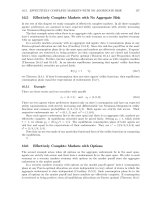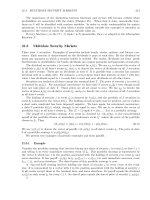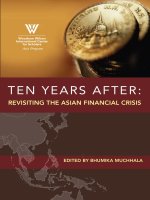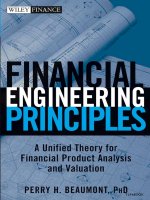Financial Engineering PrinciplesA Unified Theory for Financial Product Analysis and Valuation phần 1 pot
Bạn đang xem bản rút gọn của tài liệu. Xem và tải ngay bản đầy đủ của tài liệu tại đây (543.59 KB, 31 trang )
TLFeBOOK
1 Head iii
Financial Engineering
Principles
A Unified Theory for Financial
Product Analysis and Valuation
Perry H. Beaumont, PhD
John Wiley & Sons, Inc.
00_200306_FM/Beaumont 8/15/03 12:39 PM Page iii
TLFeBOOK
00_200306_FM/Beaumont 8/15/03 12:39 PM Page iii
TLFeBOOK
Financial Engineering
Principles
00_200306_FM/Beaumont 8/15/03 12:39 PM Page i
TLFeBOOK
Founded in 1807, John Wiley & Sons is the oldest independent publishing
company in the United States. With offices in North America, Europe,
Australia, and Asia, Wiley is globally committed to developing
and marketing print and electronic products and services for our
customers’ professional and personal knowledge and understanding.
The Wiley Finance series contains books written specifically for finance
and investment professionals as well as sophisticated individual investors
and their financial advisors. Book topics range from portfolio management
to e-commerce, risk management, financial engineering, valuation, and
financial instrument analysis, as well as much more.
For a list of available titles, please visit our Web site at
www.WileyFinance.com.
00_200306_FM/Beaumont 8/15/03 12:39 PM Page ii
TLFeBOOK
1 Head iii
Financial Engineering
Principles
A Unified Theory for Financial
Product Analysis and Valuation
Perry H. Beaumont, PhD
John Wiley & Sons, Inc.
00_200306_FM/Beaumont 8/15/03 12:39 PM Page iii
TLFeBOOK
Copyright © 2004 by Perry H. Beaumont, Ph.D. All rights reserved.
Published by John Wiley & Sons, Inc., Hoboken, New Jersey.
Published simultaneously in Canada.
No part of this publication may be reproduced, stored in a retrieval system, or transmitted in
any form or by any means, electronic, mechanical, photocopying, recording, scanning, or oth-
erwise, except as permitted under Section 107 or 108 of the 1976 United States Copyright Act,
without either the prior written permission of the Publisher, or authorization through payment
of the appropriate per-copy fee to the Copyright Clearance Center, Inc., 222 Rosewood Drive,
Danvers, MA 01923, 978-750-8400, fax 978-750-4470, or on the web at www.copyright.com.
Requests to the Publisher for permission should be addressed to the Permissions Department,
John Wiley & Sons, Inc., 111 River Street, Hoboken, NJ 07030, 201-748-6011, fax 201-748-
6008, e-mail:
Limit of Liability/Disclaimer of Warranty: While the publisher and author have used their best
efforts in preparing this book, they make no representations or warranties with respect to the
accuracy or completeness of the contents of this book and specifically disclaim any implied war-
ranties of merchantability or fitness for a particular purpose. No warranty may be created or
extended by sales representatives or written sales materials. The advice and strategies contained
herein may not be suitable for your situation. You should consult with a professional where
appropriate. Neither the publisher nor author shall be liable for any loss of profit or any other
commercial damages, including but not limited to special, incidental, consequential, or other
damages.
For general information on our other products and services, or technical support, please con-
tact our Customer Care Department within the United States at 800-762-2974, outside the
United States at 317-572-3993 or fax 317-572-4002.
Wiley also publishes its books in a variety of electronic formats. Some content that appears in
print may not be available in electronic books.
For more information about Wiley products, visit our web site at www.wiley.com.
Library of Congress Cataloging-in-Publication Data
Beaumont, Perry H., 1961-
Financial engineering principles: a unified theory for financial
product analysis and valuation / Perry H. Beaumont.
p. cm. — (Wiley finance series)
Published simultaneously in Canada.
ISBN 0-471-46358-2 (cloth)
1. Financial engineering. I. Title. II. Series.
HG176.7.B42 2003
658.15’224—dc21 2003011338
Printed in the United States of America.
10987654321
00_200306_FM/Beaumont 8/15/03 12:39 PM Page iv
TLFeBOOK
For my wife, Alexandra, with love and devotion
00_200306_FM/Beaumont 8/15/03 12:39 PM Page v
TLFeBOOK
Currencies
Bonds
Equities
00_200306_FM/Beaumont 8/15/03 12:39 PM Page vi
TLFeBOOK
1 Head vii
FOREWORD IX
PREFACE XI
INTRODUCTION XVII
PART ONE
Products, Cash Flows, and Credits 1
CHAPTER 1
Products 3
CHAPTER 2
Cash Flows 15
CHAPTER 3
Credit 73
PART TWO
Financial Engineering, Risk Management, and Market Environment 111
CHAPTER 4
Financial Engineering 113
CHAPTER 5
Risk Management 171
CHAPTER 6
Market Environment 241
INDEX 271
Contents
vii
00_200306_FM/Beaumont 8/15/03 12:39 PM Page vii
TLFeBOOK
00_200306_FM/Beaumont 8/15/03 12:39 PM Page viii
TLFeBOOK
1 Head ix
Casting aside the traditional notion of financial products grouped within dis-
tinct, relatively isolated asset classes, Beaumont insightfully uncovers com-
mon characteristics that allow the practitioner to better understand
interrelationships between bonds, equities, and currencies. Importantly, the
author drafts a hands-on roadmap to help investors manage these asset man-
agement building blocks within an integrated portfolio context.
Moving aggressively away from “box thinking,” the author creatively
develops an applied geometry of self-contained triangles to accent the essen-
tial functional qualities of various product or cash flow categories. Macro-
topics are then added around the perimeter of these triangles to illustrate
common traits or themes that the author pulls together to help weave the
complex fabric of financial engineering.
The text and the entire Appendix for Chapter 4 are peppered with prac-
tical examples that give Financial Engineering Principles a “real world” fla-
vor. In this way, professionals and laypersons alike have access to a virtual
Global Positioning System to safely and swiftly navigate the most challeng-
ing of financial straits, even as the market environment changes, strategic
courses are recalibrated, and new investment vehicles evolve.
Particularly timely, in a global financial arena marked by periods of
excessive volatility and widespread uncertainty, Beaumont devotes an entire
chapter to strategies and instruments that can help the portfolio manager
better quantify, allocate, and manage (or hedge) critical investment risks. By
employing a fresh cross-market approach, the author draws not just on prod-
uct-related risk drivers, but also on cash flow and credit interrelationships
to develop a richer, more powerful approach to risk management.
Financial Engineering Principles combines the best of a well-crafted
“practitioner’s guide” with an invaluable “reference work” to give readers
a financial engineering tool that will undoubtedly become one of the most
used tools in their investment management tool chest.
Gilbert A. Benz
Executive Director
Investment Solutions
UBS, Zurich, Switzerland
Foreword
ix
00_200306_FM/Beaumont 8/15/03 12:39 PM Page ix
TLFeBOOK
00_200306_FM/Beaumont 8/15/03 12:39 PM Page x
TLFeBOOK
1 Head xi
After nearly 20 years in the financial industry, and with assignments that
have taken me to every corner of the globe, it is only now that I feel this
book could be written.
In my first text, Fixed Income and Synthetic Assets, the idea was to trek
from the front of the yield curve to the back and provide ideas for how a
properly equipped financial toolbox could help identify trading strategies and
perhaps even assist with creating new financial products in the world of fixed
income.
Here my goal is to introduce a unifying theory among the various fac-
tors that make up the world of finance. The three fundamental factors to
this unified theory are products, cash flows, and credit. With a solid ground-
ing in these first principles, we will show how any financial security can be
better understood by financial professionals, students, or individual investors
who desire to go beyond more basic financial concepts.
After having spent years teaching about the financial markets, I continue
to find it disheartening that some students feel that global markets are far
more disparate than they are similar and shy away from thinking in a more
eclectic and encompassing way about the world. There are many common
elements across markets, and the potential insights to risk and reward that
can be gained from a more unified approach are simply tremendous.
While one overall goal of the book is to highlight the unifying aspect of
my approach to these key financial markets, the chapters can be quite
instructive on a stand-alone basis. By this I mean that a reader who is pri-
marily interested in bonds will not have to read any chapters beyond those
within the bond sections to fully capture the essence of that product type.
To this end, it bears emphasizing that when I refer to a unifying theory of
the financial markets, I am referring both to a unifying aspect within each
market segment and across them.
We are most certainly at a crucial juncture of the markets today. Recent
lessons have shown us that a new market dialogue is required. The generic
labels commonly used within finance today do not convey the same mean-
ing and value that they did years ago. A blanket reference to a bond versus
an equity ought no longer to evoke a sense of the former being a safer invest-
ment than the latter; just the opposite may be true in today’s highly engi-
neered marketplace. Unfortunately, the new kind of dialogue that financial
professionals must now practice does not fit the easy classifications that
suited the marketplace for decades if not centuries. It is not nearly enough
Preface
xi
00_200306_FM/Beaumont 8/15/03 12:39 PM Page xi
TLFeBOOK
xii PREFACE
Chapter 2
Cash Flows
Chapter 3
Credit
Chapter 6, Market Environment
Chapter 1
Products
Chapter 4, Financial Engineering
Chapter 5, Risk Management
Equities
Bonds Spot
OptionsCurrencies
Forwards &
Futures
Issuers
Cash FlowsProducts
FIGURE P.1 High-level overview of chapters and topics.
to state that credit is a factor that permeates all markets, or that legal con-
siderations are key when determining what happens in the event of a
default. What is now absolutely essential is a clear understanding of the inter-
relationships among these (and many other) market dynamics and how the
use of such tools as probability theory and historical experience can help to
guide informed and prudent decision making.
The world of finance is not necessarily a more complex place today, but
it is most certainly a different place. A large step toward understanding the
new order is to embrace the notion of how similar financial products truly
are rather than to perpetuate outlived delineations of how they are so dif-
ferent. The dialogue in support of this evolution does not require a new, dif-
ferent vocabulary; rather we must use our existing vocabulary in a richer
and more meaningful way to portray more accurately a relevant perspective
of a security’s risk and reward profile. Terms like “duration” and “beta”
00_200306_FM/Beaumont 8/15/03 12:39 PM Page xii
TLFeBOOK
have been around for a long time and are commonly used, though they are
woefully insufficient now as stand-alone concepts; they are much more valu-
able to investors when seen in broader context alongside other financial mea-
sures. This text shows why and presents new ways that long-standing
metrics of risk and return can be combined to assist with divining creative
and meaningful market insights.
Figure P.1 presents the layout of the entire book within a single diagram.
The concepts of products (bonds, equities, and currencies), cash flows (spot,
forwards and futures, and options), and credit (products, cash flows, and
issuers) are intended to represent more specific or micro-oriented consider-
ations for investors. Conversely, the concepts of financial engineering (prod-
uct creation, portfolio construction, and strategy development), risk
management (quantifying risk, allocating risk, and managing risk), and mar-
ket environment (tax, legal and regulatory, and investors) are intended to
represent more general or macro-oriented considerations. While the micro-
topics are presented pictorially as self-contained triangles to suggest that
these are the building blocks of finance, the macrotopics are presented
around the perimeter of the triangle to suggest that these are broader and
more encompassing concepts. Two of the three topics in Chapter 3 are the
titles of Chapters 1 and 2. The significance of this is twofold: It highlights
the interrelated nature of markets, and it points out that credit is an
extremely important aspect of the market at large.
Let’s begin!
Preface xiii
00_200306_FM/Beaumont 8/15/03 12:39 PM Page xiii
TLFeBOOK
00_200306_FM/Beaumont 8/15/03 12:39 PM Page xiv
TLFeBOOK
1 Head xv
A work of this type typically is successful only because of the support and
assistance of a variety of individuals, and for me this is one of the most
rewarding aspects of engaging in a project such as this. The sacrifices asked
of immediate family, in particular, are usually great, and I am most grateful
to my wife, Aly, and my sons, Max, Jack, and Nicholas, for indulging their
husband and father in this latest work. Another dimension of this book is
that during the time of its writing I had the good fortune to live and work
on two continents and with global responsibilities. These experiences pro-
vided considerable food for thought, and I am grateful for that. I also want
to thank the anonymous reviewers of this text, though I fully accept any
errors as being completely my own. Finally, for their assistance with prepar-
ing this book, I want to thank Elena Baladron and Thomas Cooper.
Acknowledgments
xv
00_200306_FM/Beaumont 8/15/03 12:39 PM Page xv
TLFeBOOK
00_200306_FM/Beaumont 8/15/03 12:39 PM Page xvi
TLFeBOOK
1 Head xvii
This text presents, for the first time, a single unified approach to building
bridges across fundamental financial relationships. The top layer of this new
methodology is comprised of products, cash flows, and credit. Products are
financial securities including equities, bonds, and currencies. “Cash flow”
refers to the structure of a security and denotes if the asset is a spot, for-
ward or future, or option. Credit is a factor that winds its way through all
of the above. As recent market events readily attest, understanding credit
risk is paramount to successful investing.
While laying the fundamental groundwork, the text examines implica-
tions for investment-making decisions and develops a framework for how
investors and portfolio managers can evaluate market opportunities. Specific
trading strategies are presented, including detailed suggestions on how port-
folio managers can build optimal portfolios.
In short, this text provides a simple yet powerful introduction to iden-
tifying value in any financial product. While primarily intended for profes-
sional portfolio managers, individual investors and students of the financial
markets also will find the text to be of value. Key financial terms are high-
lighted in italics throughout the book for easy reference and identification.
While one obvious benefit of specialized texts is that they offer an in-
depth view of particular classes of financial products, an obvious short-
coming is that readers gain little or no appreciation for hybrid securities or
alternative investments. Is a preferred stock an equity by virtue of its credit
rating and the fact that it pays dividends, or is it a bond owing to its fixed
maturity date and its maturity value of par? With the rapid pace of finan-
cial innovation, convenient labels simply do not apply, and this is especially
the case today with credit derivatives. Thus, by virtue of its focus on the
dynamics of processes and interrelationships as opposed to more definitional
and static concepts, this text provides a financial toolbox that is equipped
to build or deconstruct any financial product that may evolve. To reinforce
this, each chapter builds on the previous one, and key concepts are contin-
uously reinforced.
Each chapter begins with a reference to a triangle of three themes that
will be explored within the chapter. A convenient property of any triangle
is that it has three points. Accordingly, if we were to label these three points
as A, B, and C respectively, point A is always one step away from either B
or C. The same can be said for point B relative to points A and C, or for
point C relative to A and B. This is a useful consideration because it sup-
Introduction
xvii
00_200306_FM/Beaumont 8/15/03 12:39 PM Page xvii
TLFeBOOK
xviii INTRODUCTION
ports the notion that while I may refer to three distinguishable niches of the
marketplace (as with equities, bonds, and currencies), I wish also to stress
how the three particular niches are also related—that they are always just
one step away from one another.
Chapter 1 provides fundamental working definitions of what is meant
precisely by equities, bonds, and currencies.
Chapter 2 presents cash flows—the way that a product is structured. The
three basic cash flow types are spot, forwards and futures, and options.
Chapter 3 presents credit. In its most fundamental form, credit risk is
the uncertainty that a counterparty cannot or will not honor its promise to
provide a good, service, or payment, and in a timely fashion. The chapter
examines credit risk from the perspective of products, cash flows, and issuers.
Chapter 4 demonstrates intra- and interrelationships among the trian-
gles presented in previous chapters and in a product creation context and
shows how hybrids can be analyzed. Indeed, with the new building block
foundation, the text demonstrates how straightforward it can be to construct
or decompose any security. Also presented are ideas on how to construct and
trade optimal portfolios relative to various strategies including indexation.
Chapter 5 continues the presentation of the unifying methodology in the
context of risk management and considers risk: quantifying, allocating, and
managing it.
Chapter 6 presents the market environment, by which is meant the more
macro-influences of market dynamics. Three fundamental macro-influences
include tax, legal and regulatory, and investor considerations.
Many senior institutional investors and those with considerable market
experience traditionally have viewed the bond, equity, and currency markets
as rather distinct and generally differentiated asset classes. Indeed, it would
not be too difficult at all to assemble a list of how these asset types are
unique. For example, the stock market is generally an exchange-traded or
listed market (including the New York Stock Exchange, NYSE), while the
currency market is generally an unlisted or over-the-counter (OTC) market,
(meaning not on an exchange), while bonds are more OTC than not,
although this situation is changing rapidly. Another point of distinction is
that over long periods of time (several years), equities generally have sported
superior returns relative to bonds, although also with a greater level of risk.
In this context, risk is a reference to the variability of returns. That is, the
returns of equities may be more variable year-to-year relative to bonds, but
over a long period of time the return on equities tends to be greater.
However, similarities among the big three products (equities, bonds, and
currencies) are much more dominating and persuasive than any differences.
But before listing these similarities, it is worthwhile to list the three points
00_200306_FM/Beaumont 8/15/03 12:39 PM Page xviii
TLFeBOOK
Introduction xix
of conventional wisdom that places these asset types into three very differ-
ent spheres.
1. Stemming largely from their different risk-reward profiles, market pro-
fessionals who actively trade within these three asset classes generally
tend to specialize. Accordingly, equity trading often is protected and iso-
lated from bond trading, and vice versa; currencies also are typically seen
as being in their own world.
2. If only from a pure marketing perspective, if asset classes are “packaged”
differently and are marketed as truly unique and individual products, it
is perhaps easy to understand why the firms that sell these products (as
well as many that buy them) are keener to accept differences than sim-
ilarities.
3. Some powerful ideas within portfolio theory suggest that meaningful
diversification can allow for appreciable return enhancement opportu-
nities while also reducing risk profiles. With this particular orientation,
the drive to carve out separate and distinct asset classes becomes more
understandable.
To avoid misunderstanding, I must emphasize that I do not mean to sug-
gest that equities, bonds, and currencies are identical or even virtually so.
However, I do wish to show how these broad asset classes are interrelated
and to indicate that while they typically have different characteristics in dif-
ferent market environments, the big three are best understood as being more
like one another than unlike. That is, the big three have many things in com-
mon, and a pedigogical approach that embraces these commonalities has the-
oretical and practical value.
Consider the following example. Typically, interest rate risk is perceived
to be dominant among bonds while price risk is perceived to be the purview
of equities. But consider the risk profile of a long-dated stock option. This
instrument type actually trades on the Chicago Board of Options Exchange
and is known as a LEAP (for long-term equity anticipation securities). As
any knowledgeable LEAP trader will readily state, interest rate risk is quite
easily a LEAP’s single greatest vulnerability among the key market variables
that are used to value an option. Why? Since an option can be seen as a lever-
aged play on the market, and since leverage means financing, the cost of that
financing is measured by an interest rate. The longer the time that a strat-
egy is leveraged, the greater the overall contribution that is being made by
the relevant financing rate. Indeed, in some instances, an option need not
have a final expiration much beyond six months to have a situation where,
all else being equal, the price value of the LEAP responds more to an incre-
00_200306_FM/Beaumont 8/15/03 12:39 PM Page xix
TLFeBOOK
xx INTRODUCTION
mental change in the finance rate than an incremental change in the LEAP’s
underlying equity price. In other words, for certain longer-dated stock
options, the greatest risk at a particular point in time may be the risk asso-
ciated with financing rather than the underlying equity. Thus, the dominant
risk of an equity future may not be an equity price risk but an interest rate
risk: the dominant risk of bonds. Some LEAP traders actually buy or sell
Eurodollar interest rate futures in combination with their equity option
trades so as to help minimize any unwanted interest rate (financing risk)
exposure. More on this later.
Without question, global financial markets do encompass much more
than equities, bonds, and currencies. To name but a few other key market
segments, there are also precious metals and commodities of every shape,
size, color, and taste. By choosing to focus primarily on equities, bonds, and
foreign exchange, this text highlights the commonality among these three
markets; I do not mean to understate the depth and breadth of other finan-
cial markets. Indeed, Chapter 5 attempts to link the unified approach to these
other markets. The underlying principles for the big three are applicable to
every type of financial product.
Why focus on equities, bonds, and currencies? They are well-established
markets, they are very much intertwined with one another, and collectively
they comprise the overwhelming portion of global trading volume. Investors
do themselves a disservice if they attempt to define the relative value of a
particular corporate bond to the exclusion of balance sheet and income state-
ment implications of that firm’s equity outlook, and vice versa. And certainly
both equity and bond investors are well advised to monitor the currency pro-
file of their investments consistently. Even for locally based portfolio man-
agers who are interested solely in locally denominated products (as with a
U.S domiciled investor interested only in U.S dollar-denominated securi-
ties), the proliferation of venues to hedge away the currency component of
a given security provides the ability to embrace a global investment outlook.
With an American Depository Receipt (ADR), for example, a U.S based
investor can purchase a U.S dollar-denominated equity listed with a U.S.
equity exchange but with the equity issuer actually domiciled outside of the
United States.
As an overlay to the analysis of key financial products, the text devotes
considerable attention to credit issues and the ways that certain uses of cap-
ital can have profound implications. The notion of symmetry across a firm’s
capital structure and associated financial instruments is not necessarily a new
idea, although it has become increasingly deserving of new and creative
insights. In an important paper written in 1958 entitled “The Cost of
Capital, Corporate Finance, and the Theory of Investment,” Franco
Modigliani and Merton Miller first suggested, among other propositions,
00_200306_FM/Beaumont 8/15/03 12:39 PM Page xx
TLFeBOOK
Introduction xxi
that the financial instrument used by a firm to finance an investment is irrel-
evant to the question of whether the instrument is worthwhile; issuing debt
to finance an acquisition, for example, will not make it a more profitable
investment than issuing equity.
1
While the “M&M propositions” came under
much attack when first introduced (notably for what were decried as unrea-
sonable assumptions underlying the propositions), in 1990 Miller received
the Nobel Prize in economics, largely due to his work in the area of capital
structure, and Modigliani received the same prize in 1985.
It has been said that a useful way of thinking about the various (per-
haps even heroic) assumptions
2
underlying the M&M propositions is that
they at least contribute to a framework for analysis. If the framework argues
for a particular type of symmetry between bonds and equities, asymmetries
may be exposed in the process of questioning key assumptions. The same
spirit of questioning ought also to be encouraged to better understand any
practical or theoretical framework. Thus, students and practitioners of
finance must question how existing financial relationships differ (or not)
from theoretical contexts and explore the implications. In essence, such
exploration is the mission of this text, which provides an innovative way to
think about market linkages and synergies and sketches a practical blueprint
that both students and practitioners can use for a variety of applications.
1
Franco Modigliani and Merton Miller, “The Cost of Capital, Corporate Finance,
and the Theory of Investment,” American Economic Review; December 1958, pp.
261–297.
2
Within the theoretical context of presenting their ideas, Miller and Modigliani
assumed that companies don’t pay taxes and that all market participants have
access to the same information. In actuality, companies certainly do pay taxes, and
in most instances worldwide there is a tax advantage with debt offerings over
equity offerings.
00_200306_FM/Beaumont 8/15/03 12:39 PM Page xxi
TLFeBOOK
00_200306_FM/Beaumont 8/15/03 12:39 PM Page xxii
TLFeBOOK









